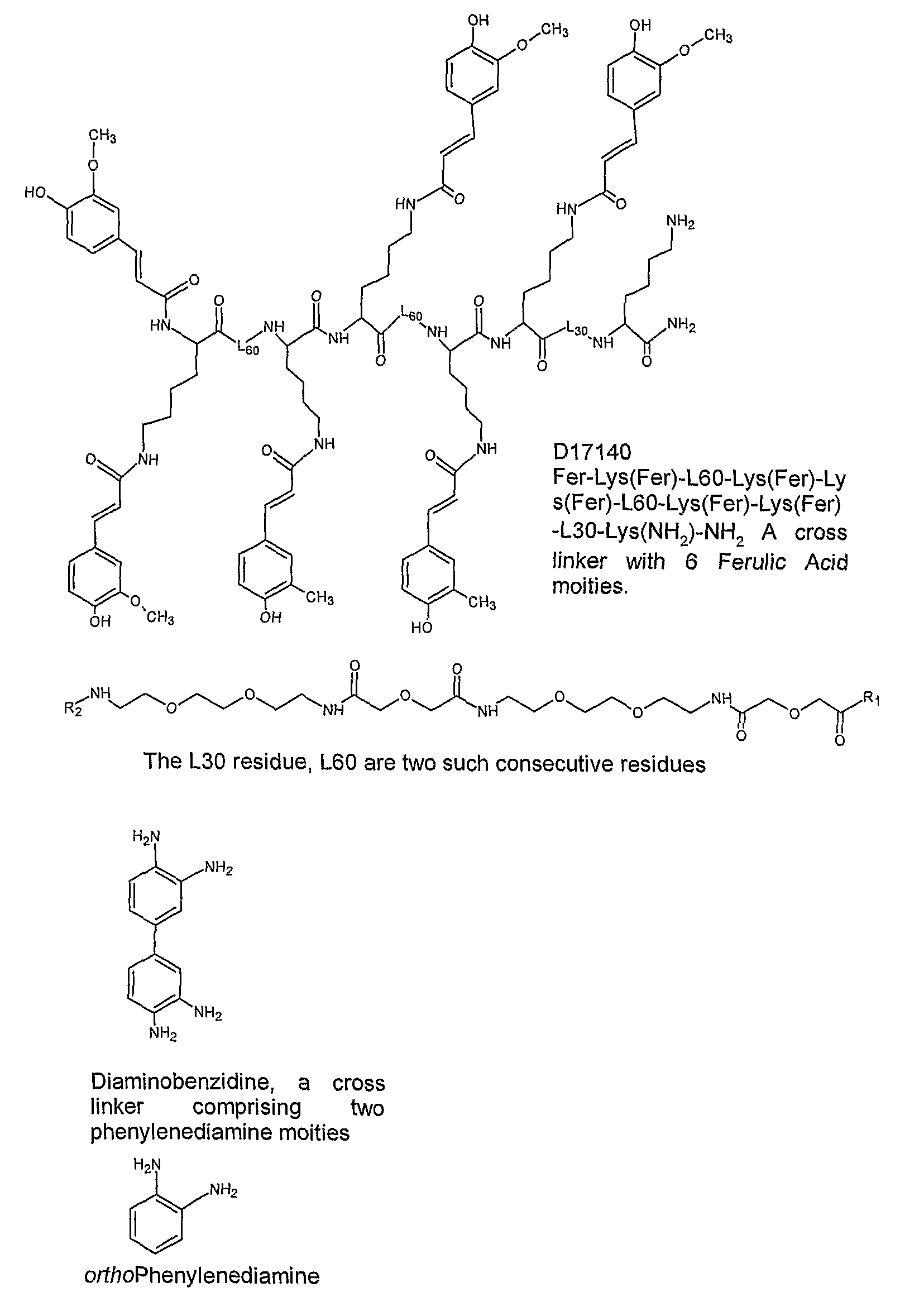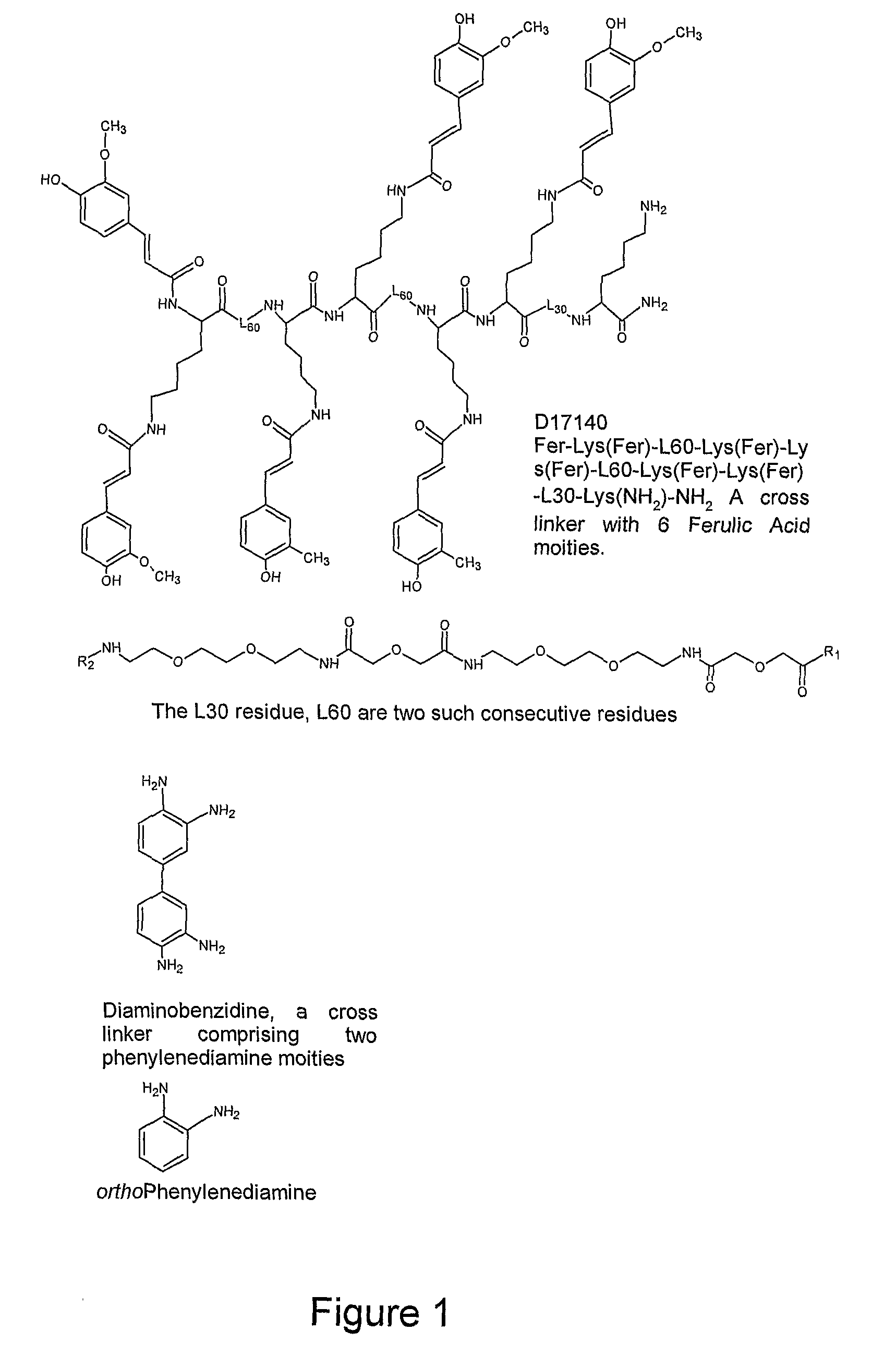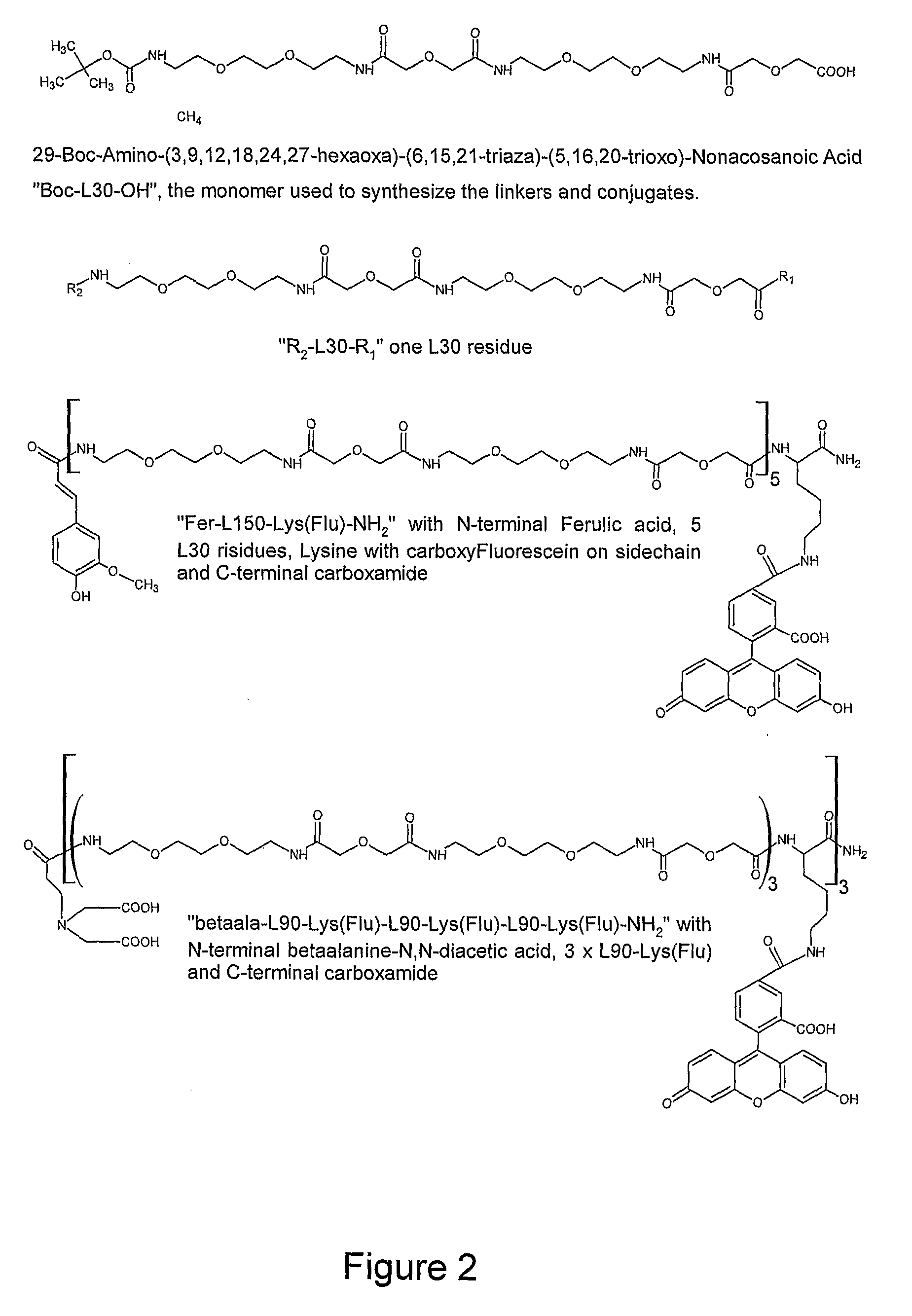Rapid and sensitive method for detection of biological targets
- Summary
- Abstract
- Description
- Claims
- Application Information
AI Technical Summary
Benefits of technology
Problems solved by technology
Method used
Image
Examples
examples
1. Examples of Reporter and Cross-Linker Molecules of the Invention
Abbreviations
[0199]MBHA 4-Methylbenzhydrylamine[0200]NMP N-Methyl Pyrolidon[0201]HATU 2-(1h-7-azabenzotriazole-1-yl-1,1,3,3 tetramethyl uronium hexafluorophosphate; methenamminium[0202]DIPEA Di / isopropyl EthylAmine[0203]DCM Dichloro Methane[0204]TFA TriFluoroacetic Acid[0205]TFMSA TriFluor Methyl Sulphonic Acid[0206]Fer Ferrulic acid[0207]FLU Fluorescein[0208]Tyr Tyrosine[0209]Lys Lysine[0210]Dex Dextran[0211]HPLC High Performance Liquid Chromatography[0212]equi. equivalent
1.1. Fer-L30-Lys(Flu)-NH2 (D17158)
[0213]MBHA resin was downloaded with Fmoc-Lys(ivDDE) to a loading of 150 micro mol / g. 200 mg resin was de-Fmoc'ed with 20% piperidine in NMP, the subjected to one coupling with Boc-L30-OH (1.5 mL 0.26 M in NMP, preactivated with 0.9 equi. HATU, 2 equivalents DIPEA for 2 min) for 20 min. The ivDDE group was removed with 5% hydrazine in NMP, and the lysine side chain was labelled with carboxy fluorescein (Flu) (1.5 m...
experiment 1
IHC
[0235]Cytokeratin, Goat-anti-Mouse-HRP and Anti-FITC-HRP each were diluted in 2% BSA, 0.2% Casein, 2% PEG, 0.1% Tween20, 0.1 M NaCL, 10 mM HEPES, pH 7.2. (BCPT-buffer). Reporter D17128 and DAB (DAKO K5007 C) were diluted in DAB substrate buffer (DAKO K5007 B). All incubations lasted 5 min, followed by 2 min wash in DAKO washing buffer S3006, except for after the incubation with D17128, where washes were performed in 10 mM CHES pH 9+0.1% Tween20.
[0236]Table and text below summarize the embodiments of the experiment:
PrimarySecondaryCross-ReporterCross-Reporterantibodyantibodylinker anddetectionlinker anddetectionDevelopingprobeprobereporterprobereporterprobesolutionSlide 1CytokeratinGaM-HRP,DAB(DAKOD18033,(DAKOM5315)125 nM,K5007 C)15 nMNoreporterSlide 4As slide 1GaM-HRP,D17128D17030DABD18033100 nM +50 nM5 nMDAB1:150Slide 7As slide 1GaM-HRP,As slide 4As slide 4D17128D17030DABD18033100 nM +50 nM0.5 nMDAB 1:150Slide 9As slide 1GaM-HRP,D17128As slide 4As slide 7As slide 7DABD1803320 nM...
experiment 2
IHC
[0238]Cytokeratin, GaM-HRP and Anti-FITC-HRP were all diluted in 2% BSA, 0.2% Casein, 2% PEG, 0.1% Tween20, 0.1 M NaCL, 10 mM HEPES, pH 7.2. (BCPT-buffer). D17128 and DAB (DAKO K5007 C) were diluted in DAB substrate buffer (DAKO K5007 B). All incubations were 5 min, followed by 2 min wash in DAKO S3006, except following the incubation with reporter D17128, wherein the washes were performed in 10 mM CHES pH 9+0.1% Tween20.
[0239]The table and text below summarize the embodiments of the experiment:
Primary &secondaryCross-linkerReporterDevelopingantibody probes& reporterprobesolutionSlideCytokeratinD17128 25D18058DAB9DAKO M5315nM noAnti-(DAKO15 nM + GaM-HRPcross-linkerFITC-HRPK5007 C)D18033 10 nM25 nMSlideAs slide 9D17128 25As slide 9DAB12nM + D17140(DAKO100 microMK5007 C)SlideAs slide 9D17128 25As slide 9DAB14nM +(DAKODAB 1:150K5007 C)
[0240]Slides 12 and 14 were strongly and specifically stained (both scoring 2), whereas slide 9 was not stained (score 0). The results show that the r...
PUM
| Property | Measurement | Unit |
|---|---|---|
| Molar density | aaaaa | aaaaa |
| Molar density | aaaaa | aaaaa |
| Biological properties | aaaaa | aaaaa |
Abstract
Description
Claims
Application Information
 Login to View More
Login to View More - R&D
- Intellectual Property
- Life Sciences
- Materials
- Tech Scout
- Unparalleled Data Quality
- Higher Quality Content
- 60% Fewer Hallucinations
Browse by: Latest US Patents, China's latest patents, Technical Efficacy Thesaurus, Application Domain, Technology Topic, Popular Technical Reports.
© 2025 PatSnap. All rights reserved.Legal|Privacy policy|Modern Slavery Act Transparency Statement|Sitemap|About US| Contact US: help@patsnap.com



